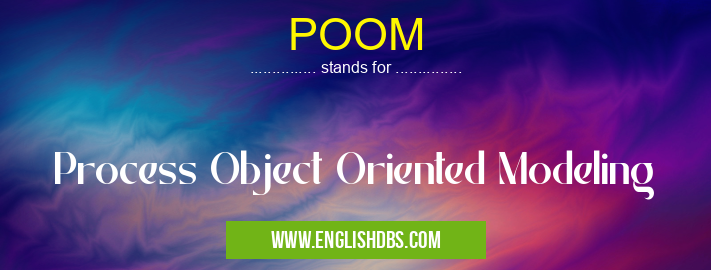What does POOM mean in UNCLASSIFIED
POOM (Process Object-Oriented Modeling) is a software development methodology that combines the principles of object-oriented programming with business process modeling. It provides a structured approach to designing and developing software applications that are both flexible and efficient.

POOM meaning in Unclassified in Miscellaneous
POOM mostly used in an acronym Unclassified in Category Miscellaneous that means Process Object Oriented Modeling
Shorthand: POOM,
Full Form: Process Object Oriented Modeling
For more information of "Process Object Oriented Modeling", see the section below.
POOM emphasizes the use of objects to represent real-world entities, such as customers, orders, and products. These objects are then organized into a hierarchical structure that reflects the business processes that the software will support.
Key Features
- Object-oriented: POOM uses objects to represent real-world entities and their relationships.
- Process-centric: POOM focuses on modeling business processes and ensuring that the software supports them effectively.
- Iterative: POOM is an iterative development methodology, meaning that the software is developed in small increments, with each iteration providing feedback for the next.
- Use case-driven: POOM uses use cases to identify the functional requirements of the software and to drive the design and development process.
Benefits
- Improved flexibility: POOM's object-oriented approach makes it easy to change and adapt software applications to meet changing business needs.
- Increased efficiency: POOM's process-centric approach ensures that the software supports business processes efficiently and effectively.
- Reduced development time: POOM's iterative development methodology helps to reduce development time by allowing developers to identify and fix problems early in the process.
- Improved communication: POOM's use of visual modeling techniques can help to improve communication between developers and business stakeholders.
Essential Questions and Answers on Process Object Oriented Modeling in "MISCELLANEOUS»UNFILED"
What is Process Object Oriented Modeling (POOM)?
POOM is a modeling technique that uses objects to represent processes within a business. It provides a structured approach to analyze, design, and implement business processes, focusing on their relationships, interactions, and dependencies.
What are the benefits of using POOM?
POOM offers several benefits, including:
- Improved process visibility and understanding
- Enhanced communication and collaboration among stakeholders
- Reduced process complexity and increased efficiency
- Facilitated process optimization and improvement
- Alignment of processes with business objectives
How does POOM differ from traditional process modeling techniques?
POOM differs from traditional techniques by emphasizing the use of objects to represent processes. This object-oriented approach allows for greater flexibility, extensibility, and reusability of process models.
What tools are available for POOM?
Several software tools support POOM, including:
- Business Process Modeling Notation (BPMN)
- Object Management Group (OMG) Business Process Modeling and Notation (BPMN)
- Unified Modeling Language (UML) Activity Diagrams
What are the key principles of POOM?
The key principles of POOM include:
- Process encapsulation: Processes are represented as self-contained objects with defined interfaces.
- Object collaboration: Processes interact with each other through message passing and object references.
- Process inheritance: Processes can inherit properties and behaviors from parent processes, facilitating code reuse and maintenance.
- Process polymorphism: Different types of processes can be represented using a common interface, allowing for flexible process execution.
Final Words: POOM is a powerful software development methodology that can help organizations to develop flexible, efficient, and cost-effective applications. By combining the principles of object-oriented programming with business process modeling, POOM provides a structured approach to design and development that can meet the challenges of today's dynamic business environment.
